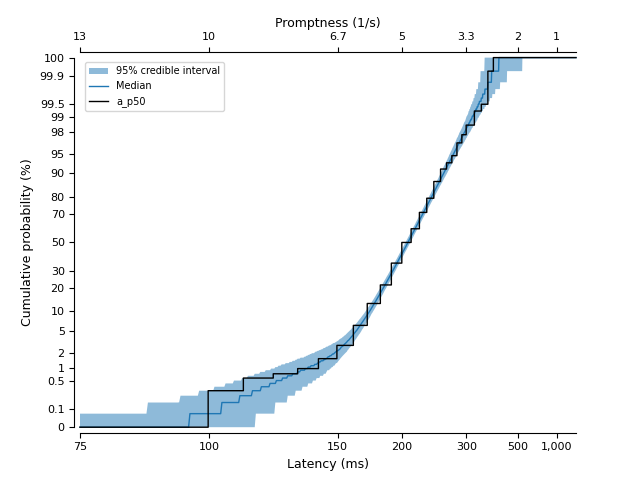Documentation
This is a Python library for working with LATER (‘Linear Approach to Threshold with Ergodic Rate for Reaction Times’) models using Bayesian methods in PyMC.
LATER is a model for distributions of reaction times, such as the time take for a person to press a button or to move their eyes after the onset of a task demand (see Carpenter and Noorani [2023] for an overview of the model and its applications).
This library provides four main features:
A LATER distribution class that can be used in PyMC models (
pylater.LATER).A visualisation helper to produce Matplotlib figures in the ‘reciprobit’ space used by LATER practitioners (
pylater.ReciprobitPlot).A method for constructing models using default priors, with optional sharing of parameters across datasets in ‘shift’ or ‘swivel’ arrangements (
pylater.build_default_model).Reaction time data digitised from Carpenter and Williams [1995] (
pylater.data.cw1995).

An example of a reciprobit plot, showing a condition from Carpenter and Williams [1995] and a summary of its posterior retrodictive distribution.
Briefly, the LATER model stipulates that a distribution of recorded reaction times can be described by the competitive combination of two Normal distributions that operate in the space of the reciprocal of reaction time (‘promptness’). The primary distribution has free parameters for location (\(\mu\)) and scale (\(\sigma\)) and the other distribution, called the ‘early’ distribution, has a fixed location parameter (\(\mu_e = 0\)) and a free scale parameter (\(\sigma_e\)). According to the LATER model, a response time on a single trial is given by the reciprocal of the maximum of independent draws from these two distributions.
Note
Also see LATERmodel for an R package with a non-Bayesian implementation of LATER and with a graphical interface.
Installation
The library can be installed using pip:
pip install git+https://github.com/unimelbmdap/pylater
Quickstart
import pymc as pm
import pylater
# load the data from the 50% condition from participant a
data = pylater.data.cw1995["a_p50"]
# build a default PyMC model
model = pylater.model.build_default_model(datasets=[data])
# sample prior predictives
with model:
idata = pm.sample_prior_predictive()
# visualise prior predictives using a reciprobit plot
priors_plot = pylater.ReciprobitPlot()
priors_plot.plot_predictive(idata=idata, predictive_type="prior")
# sample a posterior
with model:
idata = pm.sample()
# look at posterior statistics
pm.stats.summary(data=idata)
# sample posterior predictives
with model:
idata = pm.sample_posterior_predictive(trace=idata, extend_inferencedata=True)
# visualise posterior retrodictives using a reciprobit plot, with overlaid data
posterior_plot = pylater.ReciprobitPlot()
posterior_plot.plot_predictive(idata=idata, predictive_type="posterior")
posterior_plot.plot_data(data=data)
References
R. H. S. Carpenter and Imran Noorani. LATER: the neurophysiology of decision-making. Cambridge University Press, Cambridge, United Kingdom, 2023. doi:10.1017/9781108920803.
R. H. S. Carpenter and M. L. L. Williams. Neural computation of log likelihood in control of saccadic eye movements. Nature, 377(6544):59–62, September 1995. doi:10.1038/377059a0.